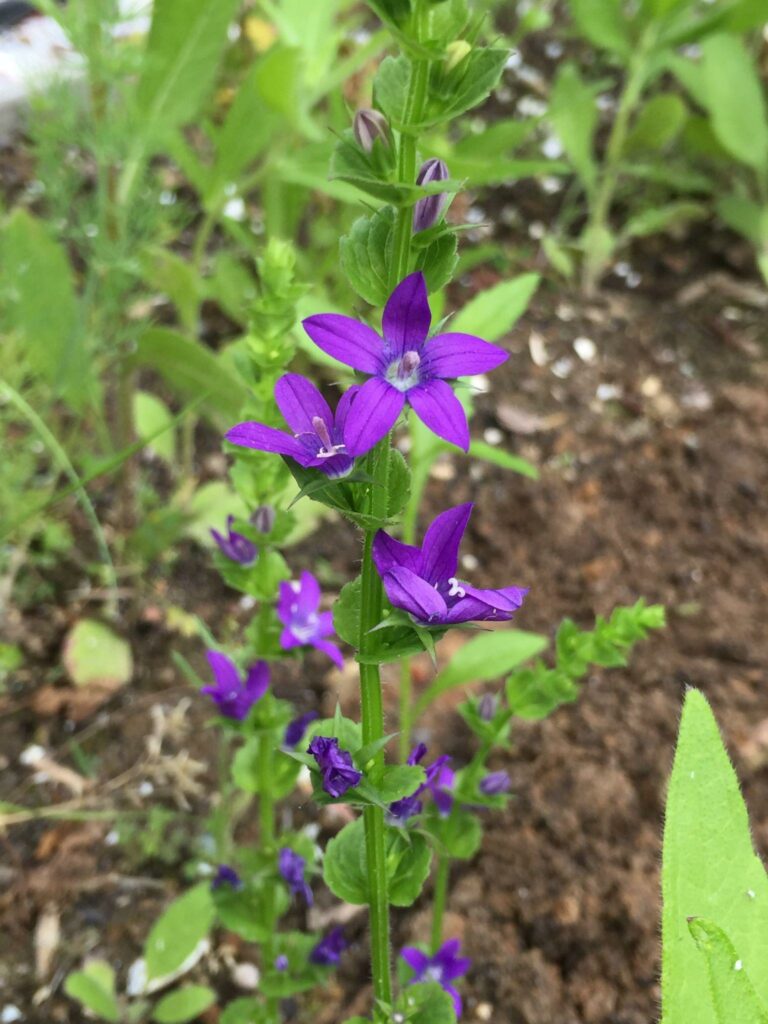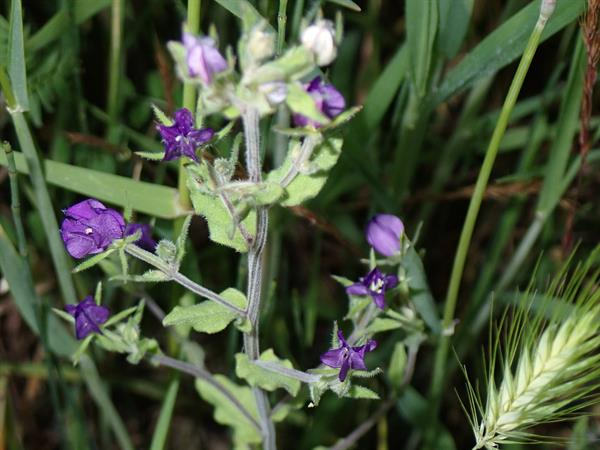Introduction
Sometimes my weeding efforts fall behind weed growth. Parts of the yard not growing tomatoes might get neglected and one year, in the oyster shell edge of the front walk, I found clumps of blue flowers mixed in the regular weeds. It was the wildflower, Triodanis perfoliata with the common name Venus Looking Glass.
The website, North Carolina Extension Gardener Plant Toolbox has an explanation for the common name: ‘its common name is derived from an early botanical description of a similar appearing plant native to Europe. That was the Legousia speculum, which had seeds that were said to be as shiny as a looking glass. The seeds of the Triodanis perfoliata … are too small to detect the shiny appearance. ’
Here is a photo of the native Venus Looking Glass, Triodanis perfoliata:

Here is a photo of a different Venus Looking Glass, native to Europe:

The similar morphology of the two versions of Venus Looking Glass in figures 1 and 2 suggests they are related. Both plants are in the family Campanulaceae but differ enough to be placed in different genus, according to taxonomists. I have some sympathy for taxonomic confusion and right now I won’t try to unravel yours or mine. We can reduce misunderstandings, at least in gardening, by using botanical nomenclature. These scientific names follow rules: Genus comes first and is always capitalized; species comes second and is always lower case. The origin of these names may reflect the old Latin name of the plant, the location of the plant, the description of the plant or other thoughts of the person who discovered the plant. We are fortunate to have the binomial system (the scientific names) to separate the two versions of Venus Looking Glass.
At first glance when Venus looking Glass is small it reminds me of corn speedwell (Veronica arvensis). However, the flowers of these plants are very different and once Venus Looking Glass stems grow tall enough (that is when I can actually see the plant without glasses) I can recognize the wildflower in the weeds.
I leave as many copies of Venus looking glass as I can go to seed and by mid June – late July the plant has faded. So far this lazy way to propagate a wildflower is working and Venus looking glass reappears each year on its own schedule.
Description of Triodanis perfoliata
This is an annual plant. The grooved stems are erect, wandlike. The flowers are violet-blue, with 5 spreading lobes in the axils of roundish, clasping (sessile) leaves. The stems may reach heights of 6 to 24 inches. Two websites, NameThatPlant.net: Triodanis perfoliata and Maryland Biodiversity Project – Clasping Venus Looking-glass (Triodanis perfoliata) have many photos which help identify the plant.
Habitat
It prefers disturbed sites, on dry sandy soil. The website bplant.org explains, ‘Humans have created a lot of habitat for this species, but it is erratic and not usually abundant.’
Faunal Associations
Small bees such as the Plasterer bee, Little Carpenter bee as well as bumblebees, flies, small butterflies and skippers frequent this plant.
Just for the ultra-curious
Dr. Jenn Weber, at Southern Illinois University, Carbondale is using Triodanis perfoliata to address crucial questions about how climate change influences plant populations (Research – Jenn Weber, PhD: Eco/Evo of flowering plants (jenniferweber.org).
Web sources for further reading
Clasping Venus’ Looking-glass (Triodanis perfoliata) – bplant.org
Maryland Biodiversity Project – Clasping Venus Looking-glass (Triodanis perfoliata)
Research – Jenn Weber, PhD: Eco/Evo of flowering plants (jenniferweber.org)
NameThatPlant.net: Triodanis perfoliata
♦ Figure 2 Image Credit:
© David Delon, some rights reserved (CC BY), uploaded by David Delon source CC-BY Weakley, A.S., and Southeastern Flora Team. 2024. Flora of the Southeastern United States Web App. University of North Carolina Herbarium, North Carolina Botanical Garden, Chapel Hill, U.S.A. https://fsus.ncbg.unc.edu/main.php?pg=show-taxon-detail.php&lsid=urn:lsid:ncbg.unc.edu:taxon:{27C5FAAE-33DE-42CE-9828-69CF9510E113} Accessed Jun 13, 2024.
